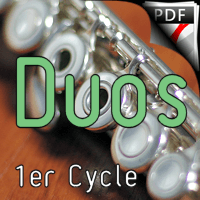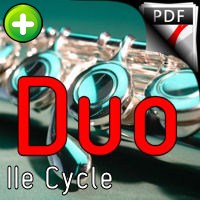Download your PDF score!
By music teachers, for their students
| Title | Author | Set | Prices | ||
|---|---|---|---|---|---|

|
38 Songs and Nursery Rhymes (Flute Duets) |
Traditionnel |
Duos de Flûtes |
14.90€ |
|

|
Christmas lullaby (String Quartet and Flute) |
Edward Grieg |
Flûte et Quatuor à Cordes (ou Piano) |
5.90€ |
|

|
La Paloma (Flute Duet) |
Sebastian Iradier |
Duo de Flûtes |
5.90€ |
|

|
5 Inventions (Flute duet) |
Jean-Sébastien Bach |
Duo Flûtes |
5.90€ |
|

|
Carmen, Entr'acte |
Georges Bizet |
Trio 2 Flûtes & Piano |
5.90€ |
The flute is one of the oldest and most widely used wind instruments. The forerunners of the modern transverse flute are wooden transverse flutes without keys similar to the modern fife. These were later modified to include between one and eight holes for chromatic notes.
Keyless transverse flutes continue to be used in folk music, especially traditional Irish music, as well as in baroque (and earlier) music concerts.
Medieval flutes (1000-1400)
Throughout the eleventh, twelfth and thirteenth centuries, transverse flutes were very rare in Europe, with the recorder dominating. The transverse flute arrived in Europe from Asia via the Byzantine Empire, where it migrated to Germany and France. These flutes are known as "German flutes" to distinguish them from others, like the recorder. The flute was used in court music, along with the viol, and was used in secular music scores, but only in France and Germany. The first literary appearance of the transverse flute is made in 1285 by Adenet the King in a list of instruments he played. After that, a period of 70 years follows, where there are few references to the flute.
Renaissance in the 17th century
From the 1470's, a military revival in Europe led to a renaissance of the flute. The Swiss army used flutes for signalling, which helped the flute to spread throughout Europe. By the end of the 16th century, flutes began to appear in court and theater music scores.
After the court music of the 16th century, flutes began to appear in scores for chamber ensembles. These flutes are often used as tenor voices. However, flutes vary greatly in size and range. This makes transposition necessary, which led flutists to use the Main guidonienne (used by singers and other musicians since their introduction in the 11th century) to transpose the music more easily.
By the 16th and early 17th centuries in Europe, the transverse flute was available in several sizes, forming a kind of consort in much the same way as recorders and other instruments. At this stage, the cross flute is usually made in one section (or two for the larger sizes) and has a cylindrical bore. As a result, this flute has a rather sweet sound and a limited range and is mainly used in "sweet consort" compositions.
The dimensions and key system of the modern western flute and its close relatives are almost entirely the work of the great flutist, composer, acoustician and silversmith Theobald Boehm, who patented his system in 1847. It was immediately popular, and spread throughout the world within a few years. Minor additions and variations on his key system are common, but the acoustic structure of the tube remains almost exactly as he designed it. The major innovations were the change from wood to metal, the large bore of the straight tube, the parabolic conical head boreThe major innovations were the change from wood to metal, the large straight tube bore, the parabolic tapered head bore, the very large keyed tone holes, and the linked key system that makes fingering a little easier. The most important deviations from Boehm's original description are the universal elimination of the "crutch" for the left hand and the almost universal adoption of Briccialdi's thumb-key mechanism. Boehm's key system, with minor variations, is considered the most efficient of all modern wind instruments, allowing trained players to play their scores with ease and extraordinary velocity and brilliance in all keys.
